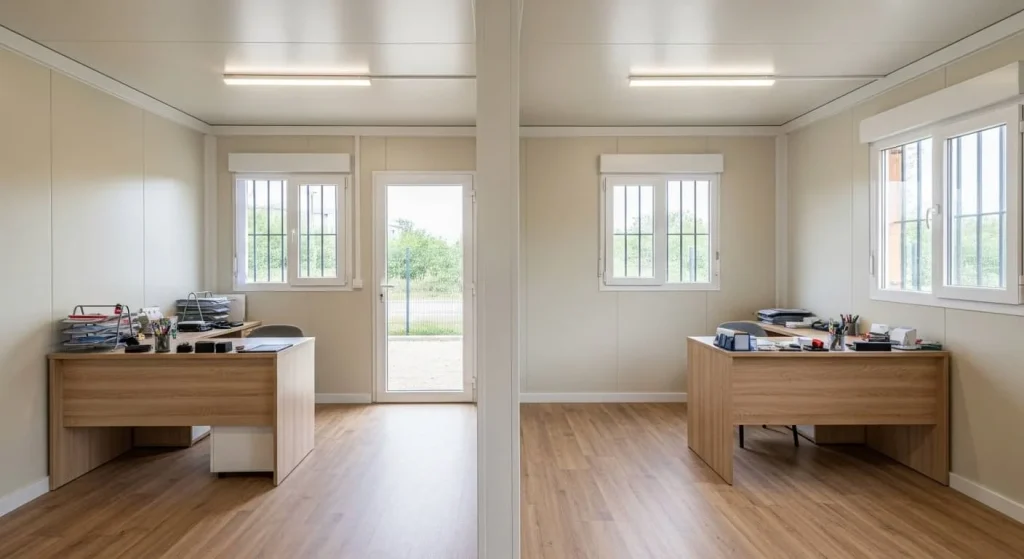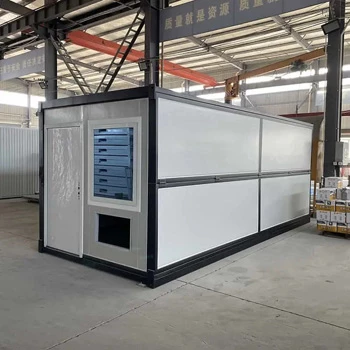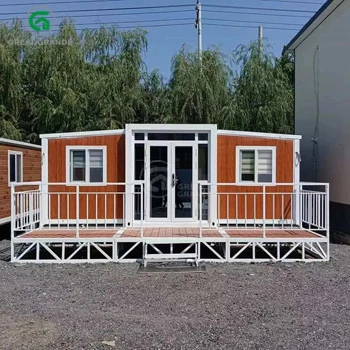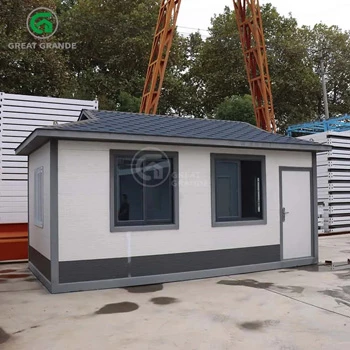Table of Contents
Folding container houses, with their unique modular design, rapid deployment capabilities, and flexible mobility, are increasingly becoming a popular choice in construction, tourism, emergency housing, and even personal living. From temporary offices and outdoor campsites to distinctive holiday cabins, their applications are expanding rapidly. However, regardless of the purpose, a stable and reliable power supply system is the cornerstone of their normal operation and comfortable living. How can we effectively address the power supply challenges of folding container homes? This requires us to deeply consider their use case, power demands, and environmental factors.
Step One: Accurately Assess Your Power Needs, Tailored for Your Folding Container
Before planning any power solution, the most crucial and fundamental step is to thoroughly inventory your power load. This is like filling a car with fuel; you need to know roughly how far it will travel to decide how much fuel to add. For a folding container home, the utilization of its internal space and the configuration of its appliances directly determine the power requirements.
- List all electrical appliances: From the lighting inside your folding container (LED lights, fluorescent lamps), heating/cooling equipment (air conditioners, electric heaters), kitchen appliances (induction cooktops, refrigerators, microwaves), to entertainment devices (TVs, sound systems), office equipment (computers, printers), and water heaters, chargers, etc.
- Record rated power: Find the power rating (Watts, W) for each appliance, usually on the appliance label or in the manual.
- Estimate usage duration and frequency: Which appliances will be used simultaneously? Which ones are used intermittently? How many hours will each be used per day?
- Calculate total power and daily electricity consumption: Sum the power of appliances used simultaneously to determine your peak power demand. Then, multiply each appliance’s power by its daily usage hours and sum them to get the total daily electricity consumption (kilowatt-hours, kWh). This data is crucial for determining the necessary battery capacity and solar panel area, ensuring your folding container always has ample power.
Accurate power assessment will help you avoid power shortages that can disrupt daily life, and also prevent over-configuration which leads to unnecessary investment.
Main Power Solutions: Choosing the Best Combination for Your Folding Container
Based on your power needs, budget, the geographical location of your folding container home, and its intended usage period, you can adopt one or more of the following power solutions:
1. Grid Connection: The Most Stable “Wired” Option for Folding Containers
Applicable scenarios: For folding container houses that are used long-term in a fixed location and are close to urban or rural power grid infrastructure, such as holiday homes, office spaces, or commercial shops.
- How it works: Apply to the local power company to connect your folding container home to the existing public power grid. Similar to traditional homes, electricity consumption is metered and billed.
- Core advantages: Stable power supply, largely unaffected by weather; ample power, capable of easily running high-power appliances inside your folding container like air conditioners and electric water heaters; convenient to use, requiring no additional operation.
- Potential challenges: Application process can be time-consuming, involving site surveys, line installation, fees, and waiting periods; location limited, the folding container must be within the grid’s coverage area; there’s a risk of power outages, dependent on the stability of the public grid.
For folding container users seeking a hassle-free power experience, grid connection is the preferred choice.
2. Solar Photovoltaic System: The Eco-Friendly Independent “Wireless” Solution for Folding Containers
Applicable scenarios: For folding container users in remote areas, off-grid locations, those seeking eco-friendly and sustainable living, or aiming to reduce long-term operating costs, such as wilderness camps, eco-farms, or mobile studios.
- How it works: Solar panels convert sunlight into DC electricity, which is then managed by a charge controller and stored in batteries. When AC power is needed, an inverter converts the DC electricity from the batteries into standard AC power for appliances. These components can be cleverly integrated into the exterior or roof structure of your folding container.
- Key system components:
- Solar panels: Monocrystalline or polycrystalline panels; choose appropriate wattage and quantity based on the folding container’s power consumption and local sunlight conditions.
- Solar charge controller: Protects batteries from overcharging and over-discharging, optimizing charging efficiency. MPPT (Maximum Power Point Tracking) controllers offer higher efficiency.
- Battery bank: The core for energy storage. Currently, common options include lead-acid batteries and lithium batteries. Lithium batteries (especially Lithium Iron Phosphate or LiFePO4) are increasingly replacing lead-acid batteries as the preferred choice due to their higher energy density, longer cycle life, smaller size, lighter weight, and lower self-discharge rate. Although the initial cost is higher, they are more cost-effective in the long run and very suitable for the limited space of a folding container.
- Inverter: Converts DC electricity to household AC power. Choose a pure sine wave inverter to protect sensitive appliances based on their power ratings.
- Core advantages: Clean and environmentally friendly, no fuel consumption, no noise pollution, perfectly aligning with the eco-friendly nature of a folding container; independent power supply, not restricted by geographical location; low long-term operating costs, once installed, there are primarily only maintenance expenses.
- Potential challenges: High initial investment, with more complex systems costing more; affected by weather, unable to generate power on cloudy days or at night, relying on stored energy in batteries; space requirements, solar panels need a certain installation area, but can cleverly utilize the roof space of the folding container.
Key tip: To maximize the efficiency of your solar system, consider installing a smart energy management system to monitor power generation, consumption, and battery status, and optimize energy distribution, allowing your folding modular tiny container house to be self-sufficient in power.
3. Diesel/Gas Generator: The Emergency and High-Power “Backup” for Folding Containers
Applicable scenarios: As a backup power source for solar or grid connections, or in specific situations requiring high power or short-term emergency power supply, such as a folding container construction site, disaster relief, or large events.
- How it works: Burns diesel, gasoline, or liquefied petroleum gas (LPG) to drive an engine that generates electricity.
- Core advantages: High power output, capable of providing substantial instant power; not limited by weather, operates as long as there’s fuel; quick response, can serve as an emergency power source, ensuring power supply for your folding container in any situation.
- Potential challenges: High operating costs (significant fuel consumption); noisy, impacting the living experience inside the folding container; exhaust emissions, not environmentally friendly and requires use in a well-ventilated area; requires regular maintenance.
A generator is a reliable backup solution, but it’s not recommended as folding container sole long-term power solution, especially in living environments where environmental friendliness and quietness are valued.
4. Hybrid Power Systems: The “Best Practice” for Folding Containers, Combining Strengths
Applicable scenarios: For folding container homes that seek both power stability and environmental sustainability, have diverse power needs, or operate in complex environmental conditions.
- Common combination modes:
- Solar + Grid Connection: Prioritizes solar power generation from the roof of your folding container during the day. If solar power is insufficient, it automatically switches to the municipal grid for supplementation. At night or on cloudy days, power is entirely supplied by the grid. Some systems even support “net metering,” allowing excess solar power to be sold back to the grid, maximizing energy benefits.
- Solar + Generator: Solar power acts as the primary clean energy source, with the generator as a backup. When solar generation is insufficient (e.g., after continuous cloudy days, battery depletion) or higher instantaneous power is needed (e.g., starting high-power tools), the generator automatically starts to charge batteries or provide direct power, offering dual protection for your folding container.
- Core advantages: Highly reliable, reducing the risks of relying on a single power source; highly flexible, allowing for adjustment of energy strategies based on actual needs; energy-efficient and eco-friendly, prioritizing the use of clean energy.
- Potential challenges: High system complexity, potentially higher design and installation costs; requires a smart control system to coordinate the switching and management of different power sources.
Hybrid systems represent a future trend, combining the advantages of various power solutions to provide the most comprehensive and stable power guarantee for folding container homes.
Ensuring Power Safety for Your Folding Container: The Unshakable Foundation
Regardless of the chosen power solution, electrical safety is paramount. This is especially critical in folding container homes, which may require frequent relocation or assembly.
- Professional design and installation: Always hire qualified electricians or energy system experts for design and installation. Improper wiring is the biggest hazard for fires and electric shocks, especially in the confined spaces of a folding container.
- Grounding protection: All electrical appliances and systems should have reliable grounding to prevent leakage accidents.
- Overload protection: Install circuit breakers, fuses, and other overload protection devices to prevent circuits from being damaged by excessive current or causing fires.
- Leakage protection: Install residual current devices (RCDs/GFCIs) to quickly cut off power in case of a leakage, protecting personal safety.
- Waterproof and moisture-proof: Especially for folding container homes used outdoors or in humid environments, wires, sockets, and switches must have appropriate waterproof and moisture-proof ratings.
- Regular inspection and maintenance: Periodically check wires for aging or damage, ensure connections are tight, and verify that equipment is operating normally.
Looking Ahead: Smart and Sustainable Power Solutions for Folding Container
As technology advances, folding container homes power solutions are becoming increasingly smart and efficient. Internet of Things (IoT) technology can enable remote monitoring of power system operation status, AI algorithms can predict power consumption patterns and optimize energy distribution, and energy storage technologies (such as solid-state batteries, flow batteries) are continuously evolving, promising higher efficiency, longer lifespan, and safer storage solutions. These technologies will truly transform your folding container into a “smart home.”
Solving the power problems of folding container homes is not just about providing electricity; it’s about creating a safe, comfortable, and sustainable living or working environment for users. Through meticulous planning and the right solution choices, your mobile home—the folding container—will truly achieve electrical freedom, unlocking endless possibilities!


About grande-house
Grande Modular Housing (Anhui) Co., Ltd. specializes in foldable container houses, offering a portable, sustainable, and affordable housing solution. Made with high-quality materials and energy-efficient manufacturing, these houses are durable and ideal for temporary shelters, disaster relief, construction sites, and residential communities. With a strong focus on sustainability and eco-friendly practices, Grande Modular Housing is committed to revolutionizing the housing industry with innovative, flexible solutions. Exceptional customer service and tailored post-installation support are at the core of their mission.






